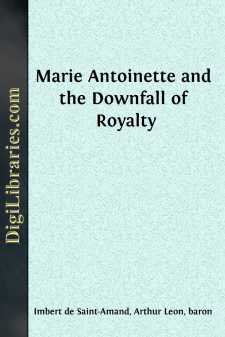Categories
- Antiques & Collectibles 13
- Architecture 36
- Art 48
- Bibles 22
- Biography & Autobiography 813
- Body, Mind & Spirit 142
- Business & Economics 28
- Children's Books 17
- Children's Fiction 14
- Computers 4
- Cooking 94
- Crafts & Hobbies 4
- Drama 346
- Education 46
- Family & Relationships 57
- Fiction 11829
- Games 19
- Gardening 17
- Health & Fitness 34
- History 1377
- House & Home 1
- Humor 147
- Juvenile Fiction 1873
- Juvenile Nonfiction 202
- Language Arts & Disciplines 88
- Law 16
- Literary Collections 686
- Literary Criticism 179
- Mathematics 13
- Medical 41
- Music 40
- Nature 179
- Non-Classifiable 1768
- Performing Arts 7
- Periodicals 1453
- Philosophy 64
- Photography 2
- Poetry 896
- Political Science 203
- Psychology 42
- Reference 154
- Religion 513
- Science 126
- Self-Help 84
- Social Science 81
- Sports & Recreation 34
- Study Aids 3
- Technology & Engineering 59
- Transportation 23
- Travel 463
- True Crime 29
Marie Antoinette and the Downfall of Royalty
Description:
Excerpt
PARIS AT THE BEGINNING OF 1792.
Paris in 1792 is no longer what it was in 1789. In 1789, the old French society was still brilliant. The past endured beside the present. Neither names nor escutcheons, neither liveries nor places at court, had been suppressed. The aristocracy and the Revolution lived face to face. In 1792, the scene has changed. The Paris of the nobility is no longer in Paris, but at Coblentz. The Faubourg Saint-Germain is like a desert. Since June, 1790, armorial bearings have been taken down. The blazons of ancient houses have been broken and thrown into the gutters. No more display, no more liveries, no more carriages with coats-of-arms on their panels. Titles and manorial names are done away with. The Duke de Brissac is called M. Cossé; the Duke de Caraman, M. Riquet; the Duke d'Aiguillon, M. Vignerot. The Almanach royal of 1792 mentions not a single court appointment.
In 1789, it was still an exceptional thing for the nobility to emigrate. In 1792, it is the rule. Those among the nobles who have had the courage to remain at Paris in the midst of the furnace, so as to make a rampart for the King of their bodies, seem half ashamed of their generous conduct. The illusions of worldliness have been dispelled. Nearly every salon was open in 1789. In 1792, they are nearly all closed; those of the magistrates and the great capitalists as well as those of the aristocracy. Etiquette is still observed at the Tuileries, but there is no question of fêtes; no balls, no concerts, none of that elegance and animation which once made the court a rendezvous of pleasures. In 1789, illusions, dreams, a naïve expectation of the age of gold, were to be found everywhere. In 1792, eclogues and pastoral poetry are beginning to go out of fashion. The diapason of hatred is pitched higher. Already there is powder and a smell of blood in the air. A general instinct forebodes that France and Europe are on the verge of a terrible duel. On both sides passions have touched their culminating point. Distrust and uneasiness are universal. Every day the despotism of the clubs becomes more threatening. The Jacobins do not reign yet, but they govern. Deputies who, if left to their own impulses, would vote on the conservative side, pronounce for the Revolution solely through fear of the demagogues. In 1789, the religious sentiment still retained power among the masses. In 1792, irreligion and atheism have wrought their havoc. In 1789, the most ardent revolutionists, Marat, Danton, Robespierre, were all royalists. At the beginning of 1792, the republic begins to show its face beneath the monarchical mask.
The Tuileries, menaced by the neighboring lanes of the Carrousel and the Palais Royal, resembles a besieged fortress. The Revolution daily augments its trenches and parallels around the sanctuary of the monarchy. Its barracks are the faubourgs; its soldiers, red-bonneted pikemen. Louis XVI. in his palace is like a general-in-chief in a stronghold, who should have voluntarily dampened his powder, spiked his cannon, and torn his flags....




